Woodley 1900-1939: From Country Estates to Housing Estates
Woodley changed little in the 19th century because most of the land was owned by landowners who had big estates: the Palmer family of Holme Park in Sonning, the Wheble family of Bulmershe Court and Mr Golding in the south near Earley.
In 1910-12 Holme Park was sold at auction including Coleman’s Moor Farm, Davis’s Farm and Lund’s Farm.
The population of Woodley and Sandford had fallen in the late 19th and early 20th century. These census figures are for the civil parish. The ecclesiastical parish of St John’s had a smaller population.
1881 – 1112
1891 – 1095
1901 – 987
1911 – 1034
1921 – 1213
1931 – 2152
There was an agricultural depression in the late 19th century. British farmers could not compete with cheaper imported food. Rental income fell and some men left to find jobs in Reading: The Great Western Railway, Huntley and Palmers, Simonds Brewery and Suttons Seeds were major employers at the time.
The outbreak of the First World War in 1914 did not have a great effect on Woodley. Rationing of meat, butter, margarine, sugar and tea was introduced in 1918. There was no bombing or civilian casualties in the local area. Agriculture and food processing were reserved occupations, so men in those jobs could not be called up. At first men volunteered to fight. Conscription was introduced in 1916. There is a War Memorial in St John’s Church listing the local men who fought in the war. Sydney Deadman of Lund’s Farm was reported killed in action, but then wrote to his parents from a German prisoner of war camp. This story and many more can be found on Woodley in WW1: the 6 panels produced by Woodley Town Council.
The Recreation field had been rented from Mr Palmer of Holme Park since 1887. In 1918 it was decided to raise the money to buy it as a memorial to the men who had died in the war. It cost £400 and contributions came from the Miss Players of The Warren, The Reverend Mr Penruddock, Captain Wheble and other members of the committee. It opened at Easter 1919 as Woodley Memorial Recreation Ground, now part of Woodford Park. The parish council decided on festivities including bowling, Punch and Judy, a band with dancing, a free tea and a souvenir for each child in the village under 14.
The depression in farming, the introduction of death duties and the deaths of young men in WW1 who would have inherited estates, led to the sales of country estates.
Bulmershe Court and the Bulmershe Estate
In 1926 the Bulmershe estate was sold. It had been owned by the Wheble family for most of the 19thcentury. The last owner was Joseph Rushbrooke. This land sale was the first important event in the 20th century history of Woodley.
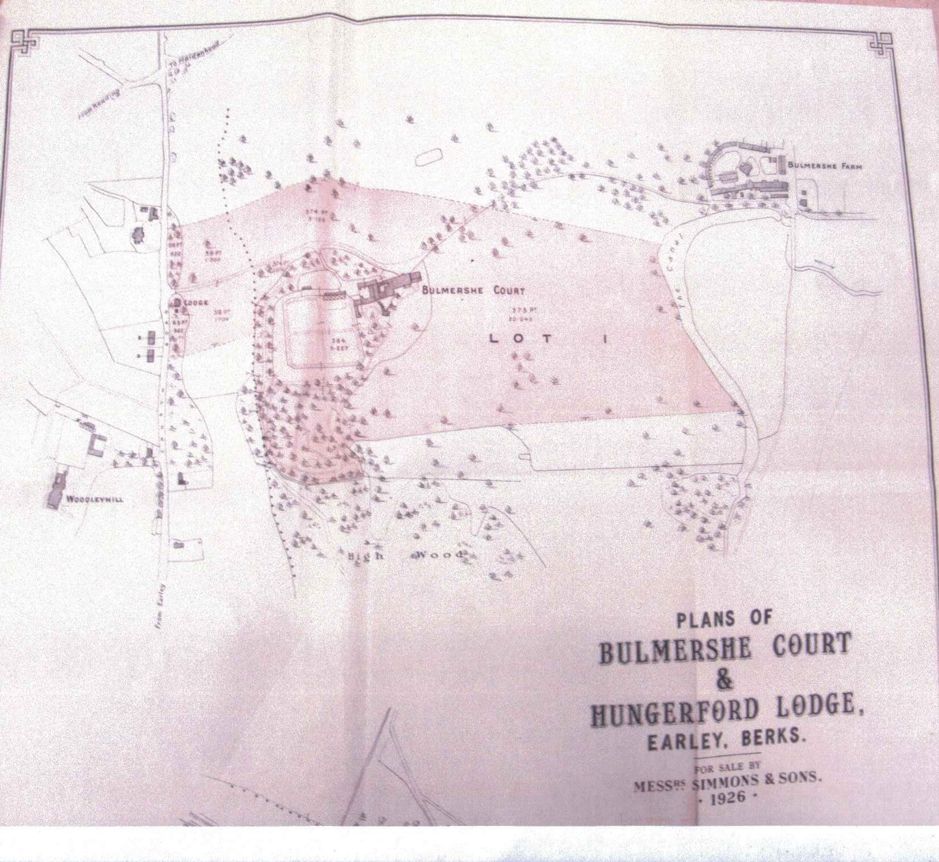
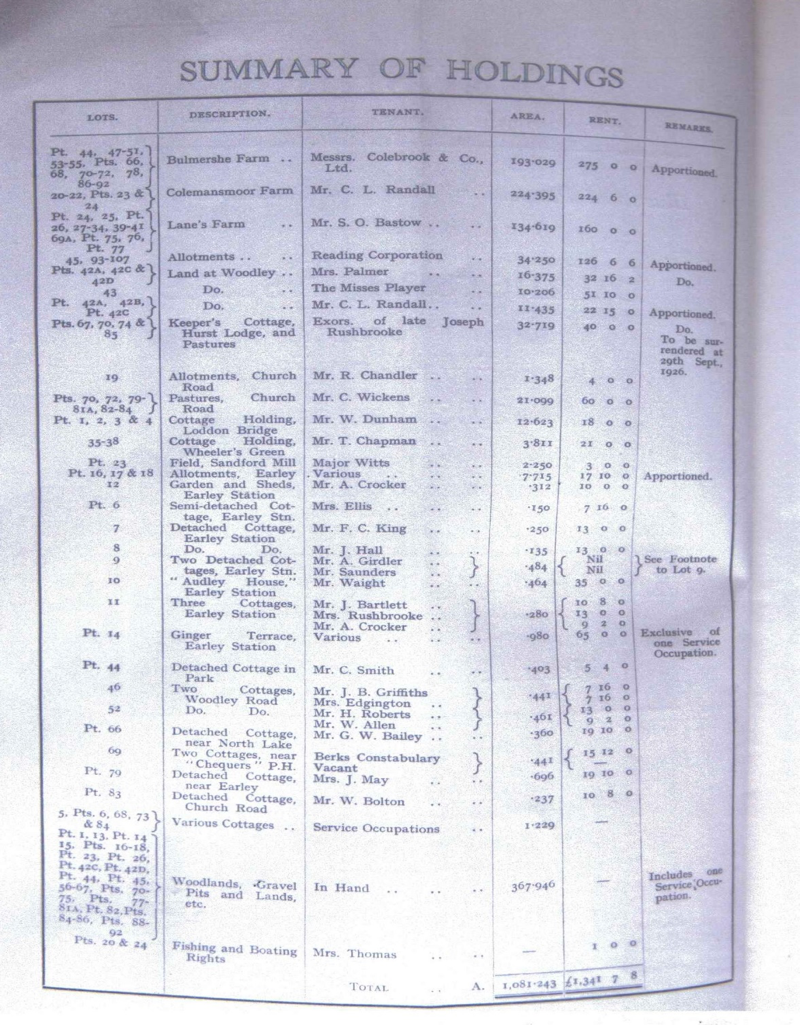
It was sold by auction as “1081 acres, the major portion of which is ripe for immediate development.” It was sold as 107 lots and the big house Bulmershe Court was Lot 1.
Bernard Short bought the estate in 1926. He reduced the size of the house from 18 bedrooms and dressing rooms to 8 bedrooms. He turned the chapel into a 100 seat theatre which he allowed local groups to use. The Earley Players performed there.
Many lots were advertised as “prime building plots ripe for development”. The ones with frontages onto existing roads like Loddon Bridge and Reading Road had houses built on them. The building line had to be at least 30 feet from the street.
There were six lodges at the entrances to the estate. They were:
Pond Head by the railway crossing. It was demolished when the A329M was built.
Crockham Well Lodge on the west side of the road opposite Crockham Well- it was let to T. Wheelwright in 1926.
East Lodge on the corner of Headley Road and Beechwood Avenue near The Chequers. It was referred to as Hurst Lodge on the 1926 sale documents, because it was on the road that led to Hurst (now Headley Road). East Lodge was the name generally used. In 1946 it was partly demolished and partly incorporated into the original St John Bosco Church.
Heath Lodge later became Heath Dairy, and is now a dog grooming parlour.
Station Lodge near Earley Station. It was demolished when the A329M was built.
West Lodge had the main drive to the big house from Church Road on the boundary with Earley.
Beechwood Avenue used to be the drive from East Lodge into the Bulmershe estate
Two cottages on the east side of Crockhamwell Road were owned by Thomas Franklin who farmed Lane’s Farm. Lane’s Farm was on the corner of Foster Lane and Loddon Bridge Road.
Coleman’s Moor Farm was let to Charles Randall.
Bulmershe Farm was let to Messrs Colebrook and Co. who were butchers and fishmongers in Reading, Wokingham and Bracknell.
There were two 6 bedroom houses near Earley Station: Audley House and Hungerford Lodge. They were sold as part of the Bulmershe Estate. Hungerford Lodge was later demolished and Stanton Road was built on the site. Audley House is still in Station Road, next to Earley Station.
Two cottages near The Chequers pub were let to the Berkshire Constabulary.
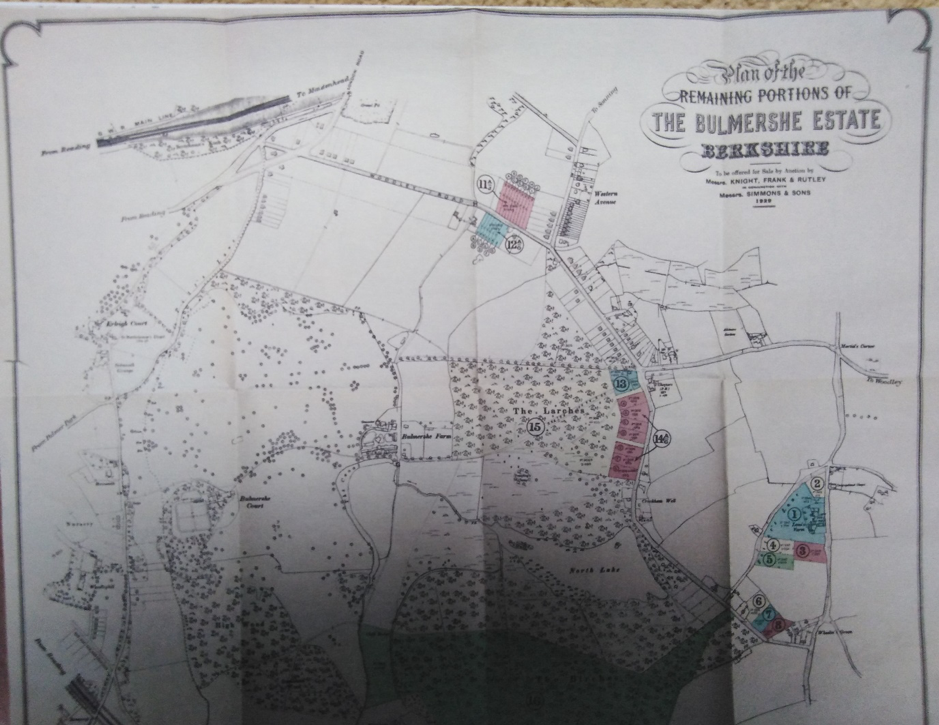
1929 Bulmershe estate map showing North Lake and the area to the Great Western railway line.
South Lake had an extension south to the Southern railway line. The Canal went from North Lake round the south side of Bulmershe farm, possibly to South Lake. The last parts of the Bulmershe estate, coloured blue and pink on the above map, were sold in 1929.
In 1939 Bulmershe Court and its grounds were sold again. The War Office requisitioned the house and grounds. Bulmershe Court was occupied by the War Office during WW2 and American soldiers were stationed there. After the war, it was dilapidated and never occupied again. Andy Petty remembers scrumping apples and playing with friends in the old house.
Bulmershe Manor
Lot 52 was “A pair of brick and tiled cottages reputed to be the remains of the original Bulmershe Court and fronting the Woodley Road (now Reading Road), Cottages let to William Allen and Mr H. Roberts.” This was the old Bulmershe Manor, the 16th century house, replaced by the new Bulmershe Court in the 18th century. The old oak staircase survived the division of the house into two cottages for farm workers.
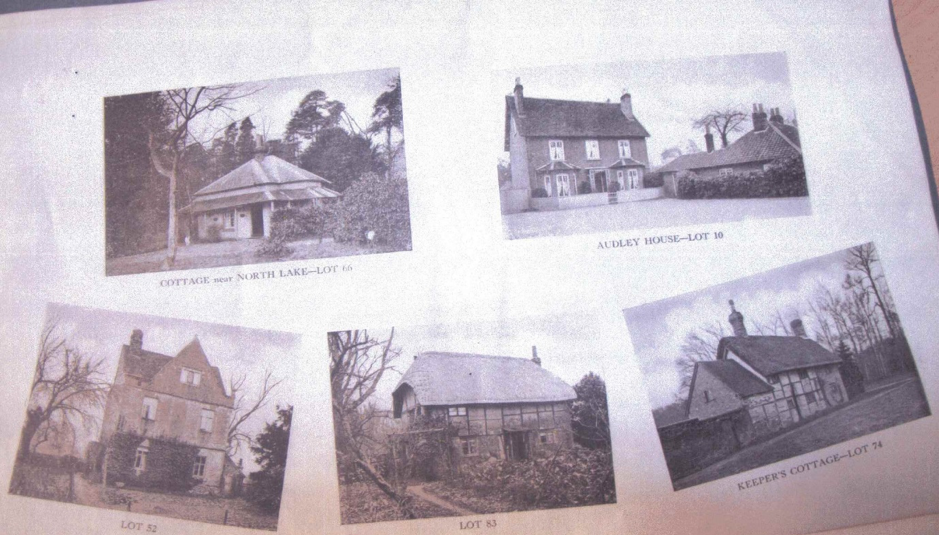
It was bought by Mr Budd who recognised its historic and architectural beauty.
He restored it using panelling and timbers from Billingbear House which had been destroyed by fire. He also put in gas, electricity and a water supply. Sadly he never lived in Bulmershe Manor because his wife thought the house was haunted.
It was sold again in 1935 as an Elizabethan Manor House with antique furniture.
In 1900 the National Telephone Company applied to Wokingham Rural District Council for permission to erect telephone poles along London Road and Wokingham Road. Woodley was about to be connected to the telephone system. But in the 1930s Woodley was still a village. Only a few houses had numbers. 1-10 Denmark Cottages in Denmark Road were built by 1907. Houses with names were built along Western Avenue by 1914. Many of the roads only got their names in 1931 when the Parish Council decided, at the request of the Post Office, to name them Butts Hill Road, Loddon Bridge Road, Headley Road and Western Avenue. Ribbon development took place along these roads. Houses had names not numbers until the late 1940s. The Reading Gas Company laid gas mains along Wokingham Road, Bath Road, Church Road, Reading Road as far as The Chequers and Western Avenue in the 1930s. Electricity supply went from Church Road in Earley to Bulmershe Court. Reading Corporation Water Supply had mains in Church Road only. Most houses had well water and cesspits. In 1939 the Parish Council annual meeting discussed the lack of street lighting and pavements in Loddon Bridge Road, which had contributed to recent car accidents.
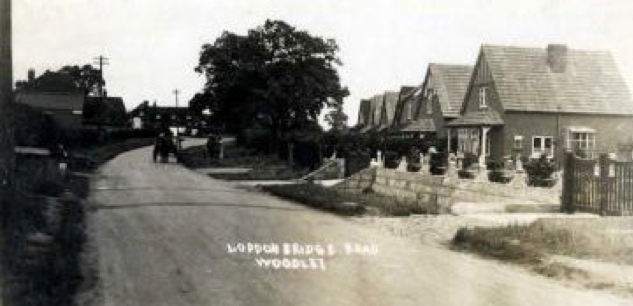
Loddon Bridge Road in the 1930s, photo courtesy of Reading Libraries.
Shops in Headley Road and Loddon Bridge Road served the growing population. For more information see the separate document Shops in Woodley.
Woodley Aerodrome
The first part of the 20th century was the time of famous aviators, and pilots pushing the boundaries of what was possible in a plane. In 1913, Monsieur Salmet on his Daily Mail tour, flew onto a field at Woodley Farm. Sir Alan Cobham came with his Flying Circus in May 1929 and gave local people their first chance to fly in an aeroplane.
The second important event in the 20th century history of Woodley was the sale in 1929 of a 100 acre field to two Reading motor engineers Jack Phillips and Charles Powis, who started an aircraft business. They set up the Phillips and Powis School of Flying which charged 12s 6d for flying lessons. They used second hand aircraft but did not manufacture them.
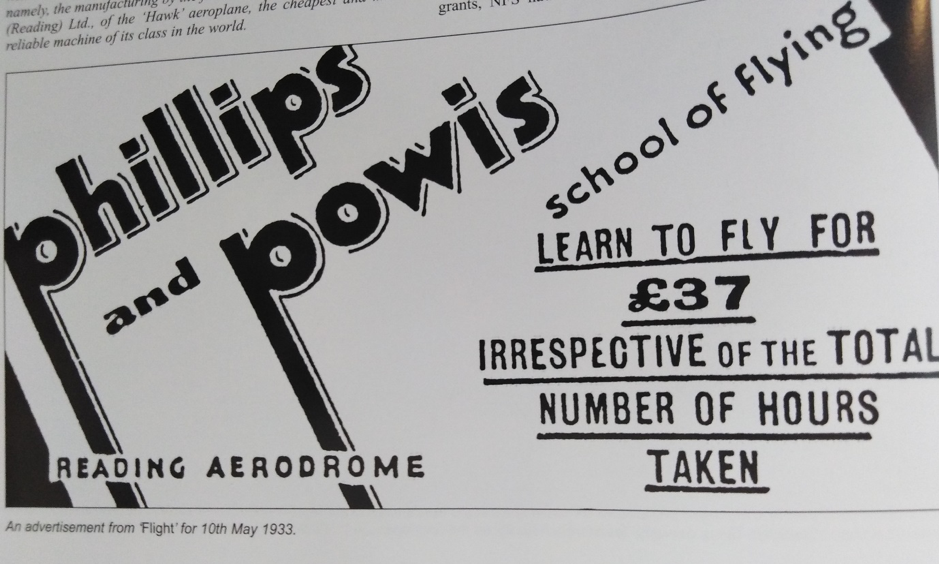
Reading Aero Club opened in 1931. Amy Johnson took part in a ladies’ handicap race. The Berks, Bucks and Oxon Flying Club and The Reading Aero Club were based at the Aerodrome. The clubhouse of the Reading Aero Club later became the Biggles Nightclub, then Raffles and finally Gatzbys.
In 1932 Charles Powis and F.G Miles agreed “to place at Mr Miles’ disposal a newly equipped Aircraft Workshop”. Phillips left the company in 1932 but the name stayed Phillips and Powis until 1943. F.G Miles was the major partner in what became known as Miles Aircraft. He was married to Blossom who took a keen interest in the business and was skilled at design. They lived in Land’s End House in Beggars Hill Road.
In September 1932 Reading Aero Club held an At Home to 80 staff members of Reading University. The Berks, Bucks and Oxon Club held an At Home on the same day at the other end of the Aerodrome, which featured an air race to Wokingham church and back.
In 1935 the King’s Cup race was won by Tommy Rose in a Falcon. The 2nd and 3rd places went to pilots of Hawk aeroplanes. Falcon and Hawk were both Miles planes.
In 1936 Charles Lindbergh visited the Aerodrome. George Miles joined his brother F.G at the company. A year later, Powis left the company.
Land’s End House was built in 1934 for Mr and Mrs Miles. It became a listed building in 1984. Lands End House, The Falcon Hotel and the Miles factory were all designed by architect Guy Morgan.
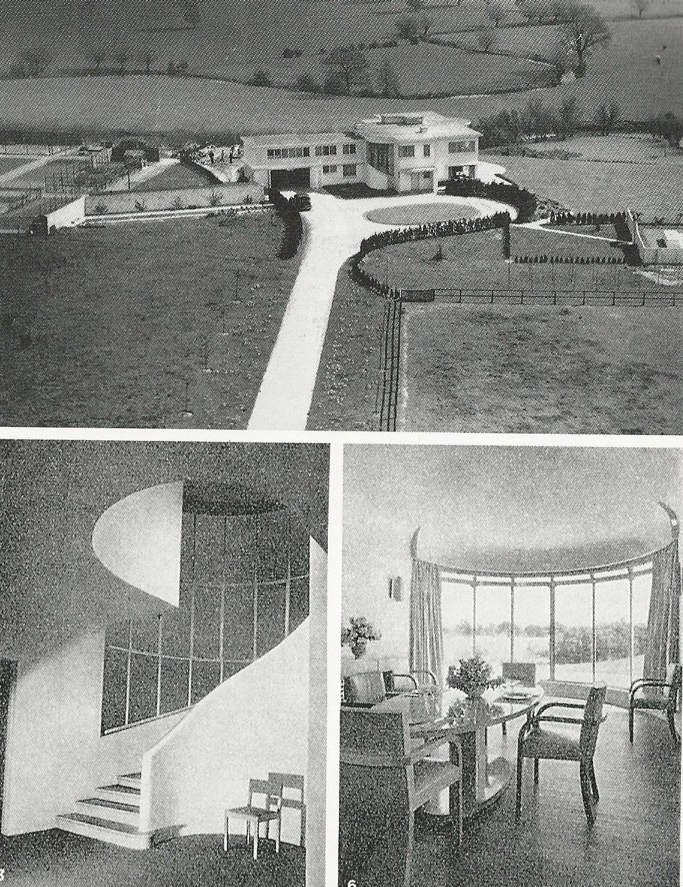
Miles made many types of wooden aircraft. The first major success was the monoplane The Hawk, which sold for £395.Their best- known aeroplane was the Magister, which was used as a training plane for the RAF.
The photo below shows The Miles Hawk with Charles Powis, F.G and Blossom Miles.
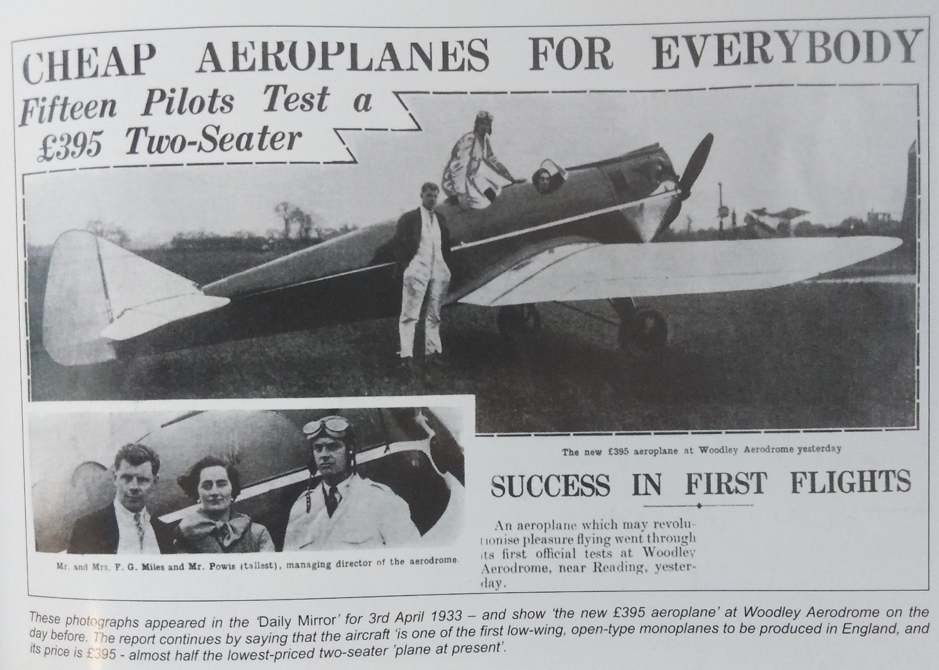
In 1931 Douglas Bader had his famous accident in which he crashed his plane, a single seater Bulldog fighter, at Woodley Aerodrome. He was taken to the Royal Berkshire Hospital. He was in the RAF at the time and had been forbidden from doing low level stunts, because of the danger. He described the accident in his log book: “Crashed slow-rolling near ground. Bad show”.
The Reading Mercury newspaper of 18 December 1931 reported the eye witness testimony of Captain R. L. Bateman who was chief instructor at the Aerodrome “I was in the clubhouse when I heard the machine flying overhead. I looked out and saw that the pilot was about 200 feet above the ground. At the time his machine was going into a slow roll and I was rather surprised at such a thing with the machine at that height. I do not think that the pilot realised he was so low. At any rate as he came off his back he lost height and speed and pancaked into the ground. The engine came away from the machine whilst the machine itself rolled over for some distance. The pilot was extracted within a couple of minutes of his machine touching the ground.” He added “We did not know the pilot at Woodley and we have no idea why he came here”.
The surgeons at The Royal Berkshire Hospital were unable to save his legs. One had to be amputated below the knee and the other above it. He was fitted with tin legs and had to learn to walk again. He was grateful to the hospital and especially to the chief surgeon Mr Joyce, and later helped them with fund raising. There is a display in a corridor at the Royal Berkshire Hospital about his links with the hospital.
There were other fatal accidents in the 1930s, some of them involving test pilots. In April 1939 The Reading Mercury reported the death of a young policeman who had recently gained his licence to fly. PC Uphill crashed while attempting acrobatics in a Miles Hawk at the Aerodrome.
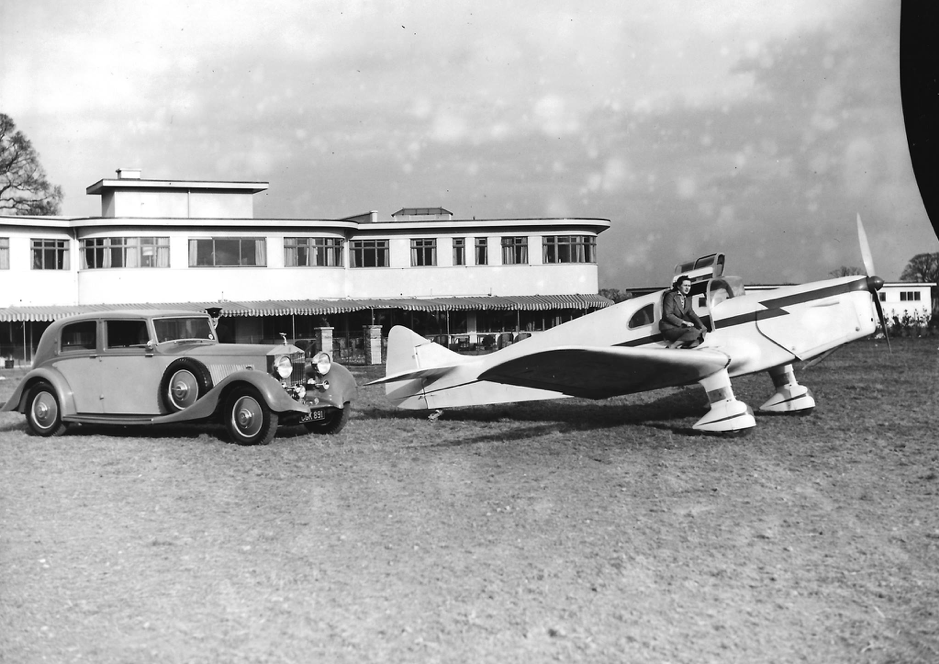
Flying was an expensive hobby in the 1930s and The Falcon Hotel was built in 1937 to accommodate rich visitors. It was at the east end of the Aerodrome, near Eleven Elms Cottage. It replaced the old clubhouse of The Reading Aero Club, which had become surrounded by factory buildings. The Falcon was owned and run by Simonds brewery. It was used by the RAF in WW2.The Falcon Hotel was damaged in an arson attack in the late 1980s and demolished to make way for the housing development on the airfield site.
The noise and pollution from the aircraft factory meant that Woodley no longer had pure country air. St Luke’s Home for Sick Children in Headley Road closed in 1936 and the children moved to Bexhill. For more information about St Luke’s see the article: St Luke’s Home for Sick Children. The building became Hawkhurst and was used as a clubhouse for the Reading Aero Club, before The Falcon was built. In WW2 it was an officers’ mess and sleeping quarters for trainee pilots.
Woodley Aerodrome had grass runways which helped to disguise it from the air in World War Two. The buildings were camouflaged so well that some pilots had difficulty finding the aerodrome on the way back from exercises. An Elementary Flying Training School for the RAF was set up when war broke out in 1939.At the height of the war, there were 5,000 people working at the Aerodrome. There was also a factory at Liverpool Road in Reading and a shadow factory in Swindon.
Increased war time traffic led to the building of a roundabout at what had been the crossroads of Headley Road with Loddon Bridge Road and Butts Hill Road: Martin’s Corner. In the 1861 census there was a Martins Road from Foster Lane to Martin’s Corner. The roundabout is now known as the Just Tiles roundabout.
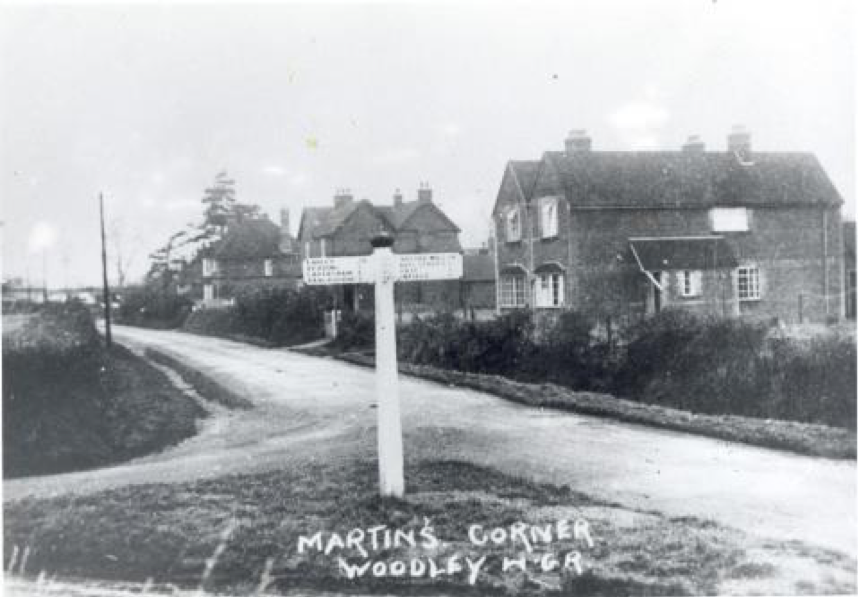
For more information about Woodley during WWII, please see the separate article: An account of Woodley during WWII.
Miles went bankrupt in 1947 and only 500 men kept their jobs. Some went to work for Handley Page who took over a year later, and some to the Miles Martin Biro Company.
The RAF kept a presence until 1955 with the Reserve Training School at the Aerodrome. By the early 1960s Handley Page had left and the Aerodrome was abandoned. Many Woodley people remember playing there as children.
In 1929 the workhouse system was abolished. The old workhouse in Cobblers City became cottages. The 1938 Ordnance Survey map shows Workhouse Moor between Headley Road East and Church Road. Woodley Institution was built in 1931 at 119 Reading Road, near the corner with Norwich Drive. Local people remember tramps on their way to it for a bed for the night. It was also known as the Casual Ward.
In 1939 The Woodley Institution was supervised by Barry Digweed and his wife Emma. Their son, also called Barry, was an ARP warden. It had 80 people living there, mostly elderly men born in the 1860s,70s and 80s. They included James Drake coal carter, Arthur Pratt builders labourer, John Blowers printers labourer, Thomas Pewsey ex Police Inspector, George Hughes builders labourer and Henry Champion clothiers manager.
It was renamed Woodlands by 1949 when the superintendent was Leslie Wicks and Mrs Wicks was the matron. It became Woodlands Old People’s Home in 1960.
Farms
In the 20th century, many farms in Woodley were sold and houses built on the sites.

Bulmershe Farm was the home farm for the estate. Rose Cottage housed farm workers. In 1926 Colebrook and Co were tenants of Bulmershe Farm. William Cook was listed as the farmer in 1940. After the end of the war, Bulmershe Court was left derelict. The farm tenants were given notice to quit in 1950 and trees were felled ready to build houses.
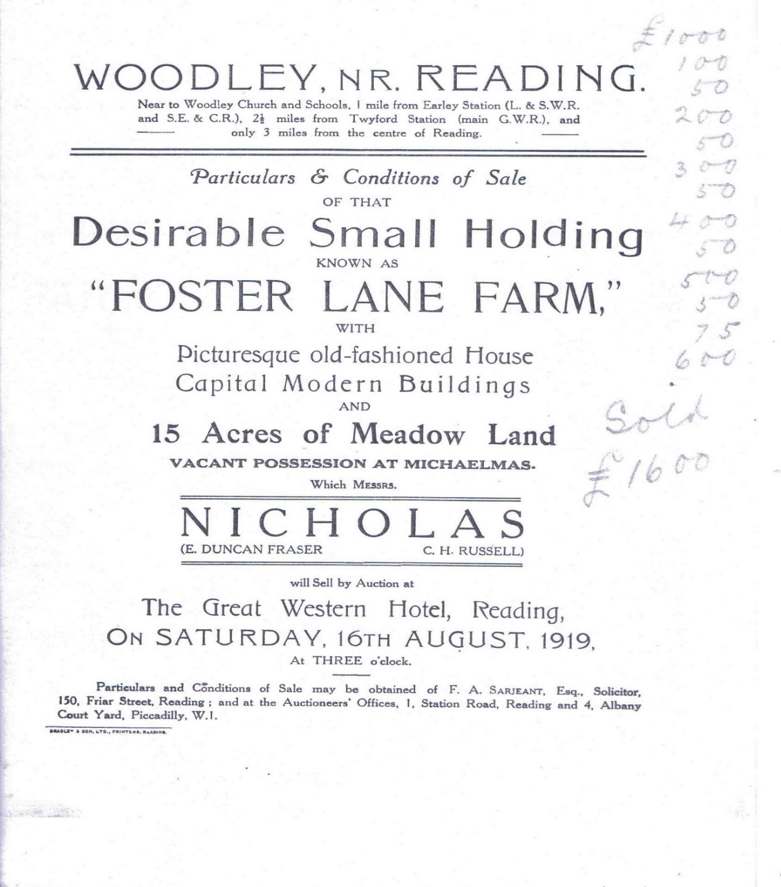
Foster Lane Farm was sold in 1919 as a small dairy farm.
Between 1930-49 Roland Richardson was a dairyman at Foster Lane Farm. In May 1943 a training plane crashed on the roof of Richardson’s farm, also known as Foster Lane Farm. The pilot was killed, the co-pilot badly injured and the plane exploded, setting fire to the house. The family escaped when they heard the plane in difficulties but the house and furniture were destroyed.
Mr Richardson was the last farmer and the farmhouse was demolished in 1950.
The 1911 census shows that Frederick Righton was the farmer at Sandford Farm. It was run by Francis Lee in 1920.
In 1930 Sandford and Davis’s Farm, east of Eleven Elms and west of the River Loddon, was auctioned. Both together were called Loddon Valley Dairy Farm. It included two miles of fishing rights on the River Loddon.
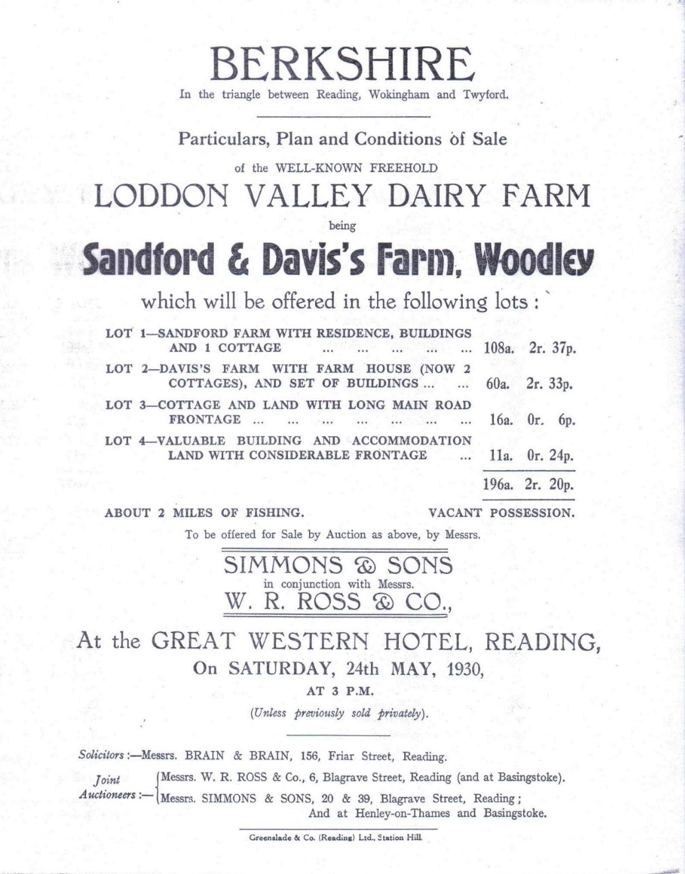
Francis Lee was still farming Sandford Farm in 1930. In 1940 – 49 Sandford Farm was run by Andrew Brown. In 1960 Geoffrey Loring was the farmer. Davis’s Farm had become derelict by 1939 and was taken over by Miles Aircraft as the site of their wind tunnel.
In 1907 Lunn’s (later Lund’s) Farm and Woodley Farm were occupied by Thomas Pither. During WW1 the farm was occupied by Mr and Mrs Deadman, whose son Sydney Deadman survived the war. See the Woodley Town Council’s WW1 panels for his story.
In 1932 Lund’s Farm, described as a half-timbered farm house, and 2 cottages were auctioned. Two cottages at Norris Green were let to Mr Tyler and Mrs Deadman. A part of the farmhouse was let to Mrs Page for 6s a week. It had well water. This was common in Woodley until after World War Two. The farm sale included 7 building plots on Church Road and more plots on Butts Hill Road. There was also Norris Copse and Workhouse Moor on Headley Road. Lund’s Farm was at the end of Church Road and Duffield Road.
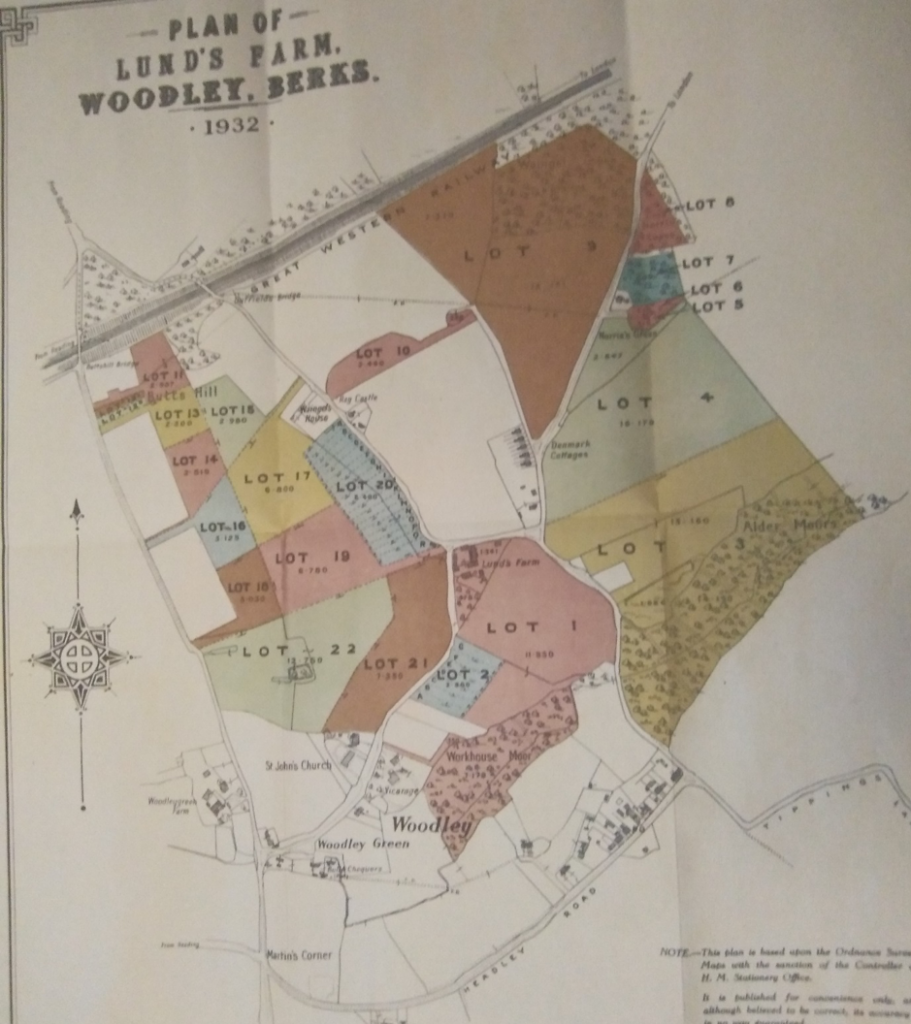
In 1907 Coleman’s Moor Farm was occupied by F.T.Lee. The following year it was sold by the Holme Park estate and bought by the Bulmershe estate. It was 209 acres. In 1920 F. Randall was the farmer at Coleman’s Moor Farm. In 1926 when the Bulmershe estate was sold, C.L. Randall was the farmer.
In 1939 it was occupied by John and Betty Christopher, with their two sons and four other people. He was described as a collector of butchers’ waste. Kelly’s directory described him as a tallow merchant. The last farmer was Mr A. Steel in 1963. The farmhouse was demolished in 1970 and the site was used for gravel extraction.
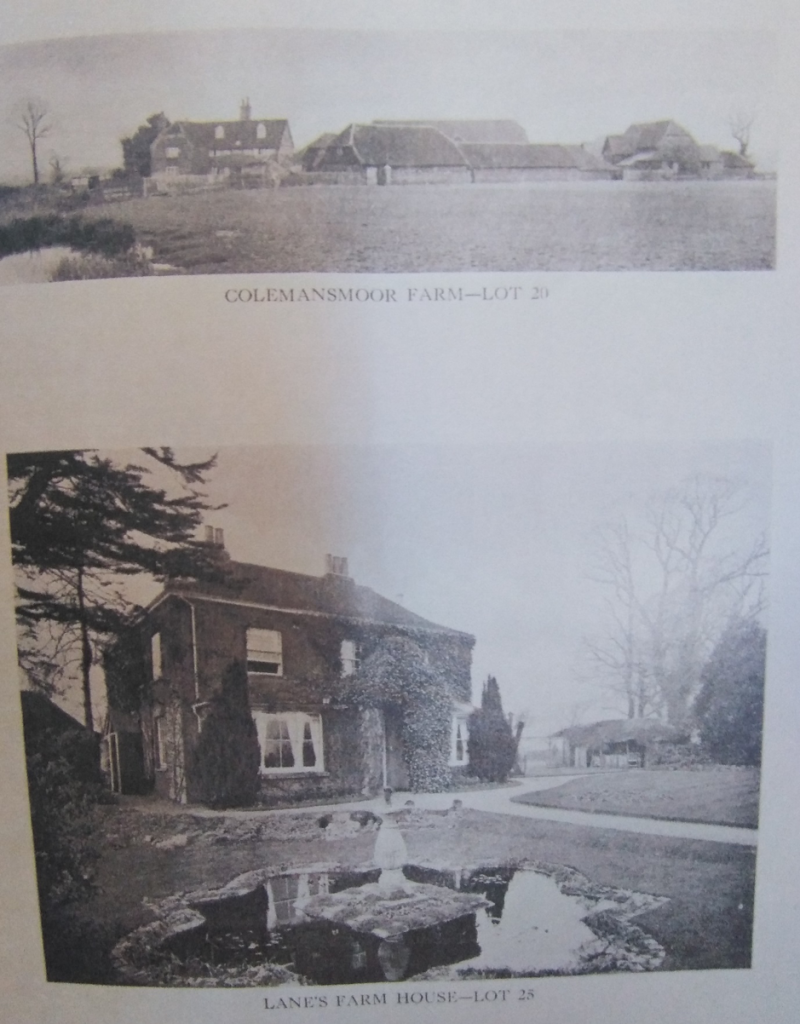
Lane’s Farm was on Loddon Bridge Road near the junction with Foster Lane. It was originally called New Farm.
Mrs Bradley took over Lane’s Farm before 1915. By 1920 the farmer was T. Franklin.
When the Bulmershe Estate was sold in 1926, the farm was let to Stephen Orchard Bastow. He was on the Parish Council in the 1930s.
The 1939 Register showed that Lane’s farmhouse, off Loddon Bridge Road, was occupied by 11 aircraft workers. In 1940 the farmer was still Mr S.O. Bastow.
1960 Kelly’s directory listed J. Smith, Rivermead Farm, Coleman’s Moor Road. This is the only mention of this farm.
1907 Kelly’s Directory and the 1911 census listed Thomas Pither as the farmer at Woodley Green. He married Sarah and their children were Charlie, Elsie, Thomas, Ada, Walter, Margaret and Joe.In 1920 Thomas Pither was still the farmer. The 1939 Register listed for Woodley Farm, Butts Hill Road: Joseph Pither farmer b 1902, Kate Pither undisclosed domestic duties- which meant housework, Philip Pither, shepherd, Ada Pither undisclosed domestic duties and Walter Pither, tractor driver. The 1949-1964 Kelly’s Directories showed E. and T. Pither as farmers at Lund’s farm and Joseph Pither farmed Woodley Green farm until its sale in the 1980s. It was the last farm in Woodley. The farmhouse was demolished because it was in poor condition. The contents were auctioned. The barn survived and is a listed building.
There were also many smallholdings and nurseries:
In 1907-15 Woodley Cottage in Loddon Bridge Road – opposite the end of Foster Lane- was occupied by a nurseryman, C. Howlett. In 1931 Alfred Weller, poultry farmer was there. In 1935 it was Clement Trenear, horticulturist at Woodley Cottage.
In 1920 Molassine Co Ltd model poultry farm, manager F. Stanley was listed in Kelly’s directory but with no address.
There was a market garden and poultry farm on Duffield Road.
In 1930 Harold Cox, market gardener lived at Coppice Farm in Reading Road. This was nothing to do with Coppice House off Loddon Bridge Road which later gave its name to Coppice Road.
In the 1930s, Thomas Phethean (sometimes spelled Phetan) was a poultry farmer at Sunnymead, Headley Road. Terry Ted was a market gardener in the same road.
The 1939 register listed Wilfrid Rosier living at Oak Tree Farm in Waingels Road, Joseph Horne nurseryman at Butts Hill Road and Albert and Bessie Dunton, poultry farm, Coleman’s Moor. These were smallholdings rather than large farms.
The Arrival of the Car
In the 1930s cars were still rare and expensive. New garages opened in Woodley to service them and to supply petrol. Cafes were built on main roads. The Shepherd’s House on London Road was built in 1930. It was run by Leslie Duguid.
The original Shepherd’s House was at the bottom of Shepherd’s Hill, on the other side of the road by the junction with Shepherd’s House Lane. It seemed to have ceased business and disappeared after 1871.
In September 1939 the Reading Mercury newspaper reported the death of a cyclist Mrs Miles (no relation to Frank and Blossom Miles), who was killed in a collision with a car in Butts Hill Road.
In the 1930s the Glow Worm Café and Garage was at 658 and 660 Wokingham Road, near the River Loddon and opposite The George. By 1940 the Sonning Cutting Filling Station was at 709 London Rd, the Wee Waif Road House and the Wee Waif Service Station were on the Bath Road, Everybody’s Café was at 24 Shepherd’s Hill, Star Motors, car dealer was on Shepherd’s Hill, the Avenue Garage was in Western Avenue with Joe Hussey as the motor engineer, and William Russell’s Garage was in Headley Road.
Between 1949-70 Great Western Motors petrol station was at 705 London Road. Loddon Bridge Motors was at 660 Wokingham Road. Previously it had been the Glow Worm garage and café. The latter site is now a private house next to The British Garden Centre at Loddon Bridge roundabout.
Bus services were supplied by Thames Valley Traction Company. Reading Corporation trams and buses only ran within the borough boundaries and Cemetery Junction was the eastern terminus.
Schools in Woodley
The first school in Woodley opened its doors on 14 May 1855, this being St. John’s C. of E. School in Church Road. The land for this school was originally donated by Robert Palmer. The original building consisted of a school house and a long room, with the infants’ classroom at the rear. Remarkably it was to remain in use, much expanded, until 1987 when a larger replacement was opened in Hurricane Way. The original building has been listed and is preserved in fine fettle.
The population of Woodley grew from 1213 in 1921 to 2152 in 1931. These figures are from the censuses. St John’s Church of England school was running out of space. Woodley Council Senior School was built in Loddon Bridge Road and opened in June 1939 to take children over the age of nine. After the 1944 Education Act it was renamed Woodley Secondary Modern School. It is now Rivermead School.
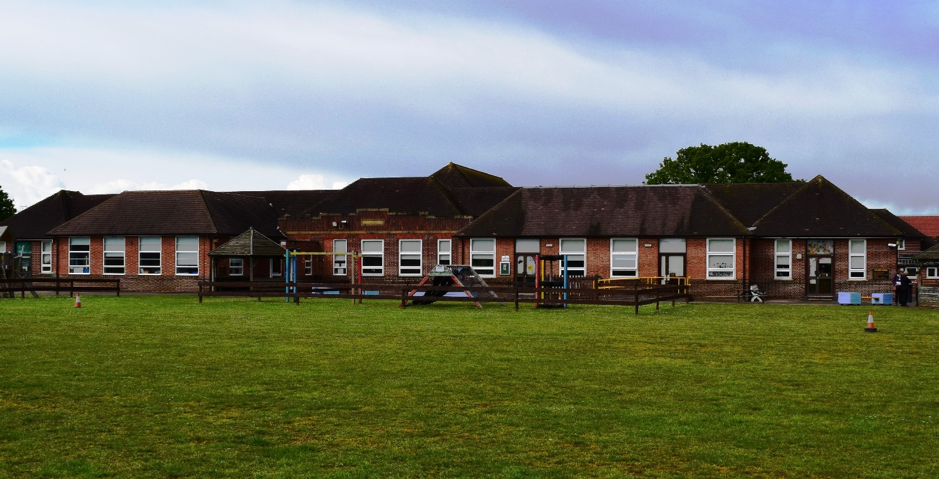
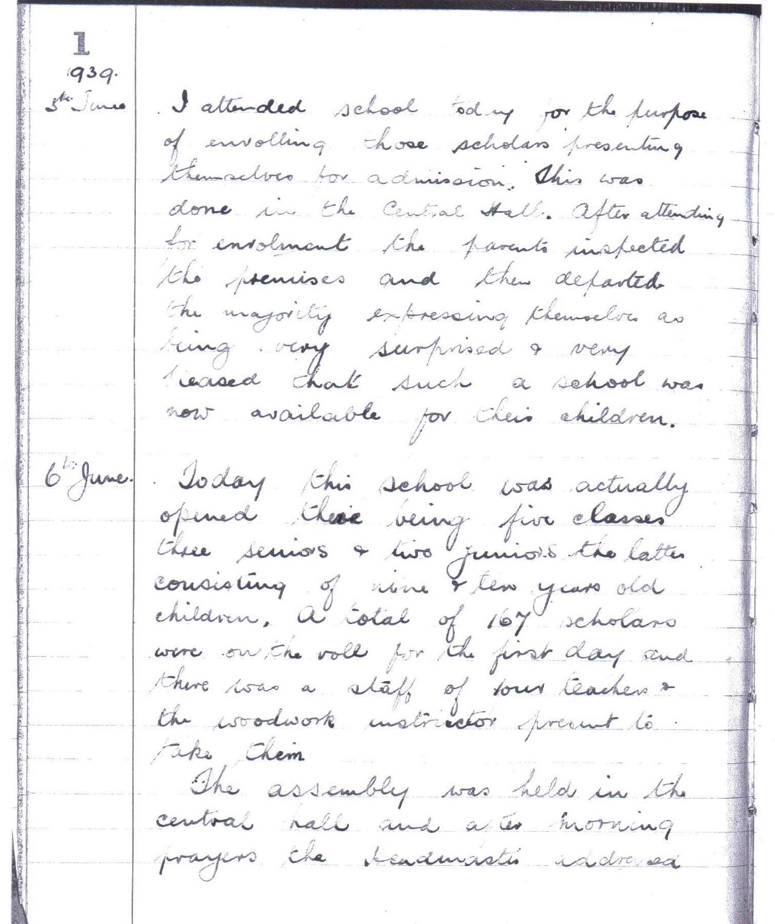
In 1939 Archbishop Tenison’s School in London was evacuated to Woodley and they were based in South Lake House.
For more information see the document The Growth of Education and Schools in Woodley (not yet available online).
The Police
The Berkshire Constabulary started in 1856. The 1915 Kelly’s directory listed H. Fisher police constable at the Police Station, The Avenue (later Western Avenue). The Bulmershe Estate had 2 cottages near The Chequers pub which were let to the Berkshire Constabulary in 1926.
In 1930 William Snelling Brooks and S.J. Holding were at the County Police Station, Bath Road.
In the 1940, Kelly’s directory there was a police station at 727 London Rd with Sergeant James Coster. William Rippington the police constable lived next door at no. 725. By 1949 Edgar Clarke was the Sergeant at the police station, and Albert Clarke was a police constable living at Erleigh House in Loddon Bridge Road. By 1970 the police station was known as Thames Valley Constabulary (Woodley Sub Divisional Station). The Woodley station was last listed at London Road in 1985.
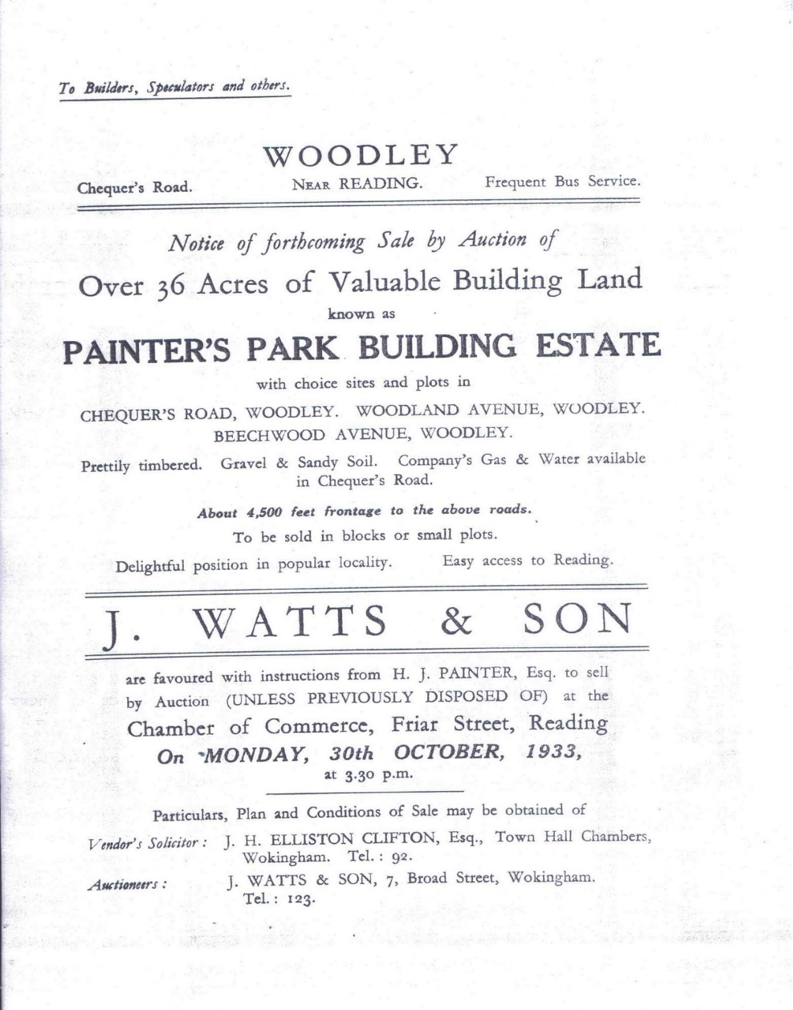
1933 Sale Catalogue for Painter’s Park building estate, Chequers Rd, (this was the northern part of Crockhamwell Rd near the pub), Woodland and Beechwood Avenues. The land was sold by Mr Harry Painter who owned the Coleman’s Moor gravel pits in the 1930s.
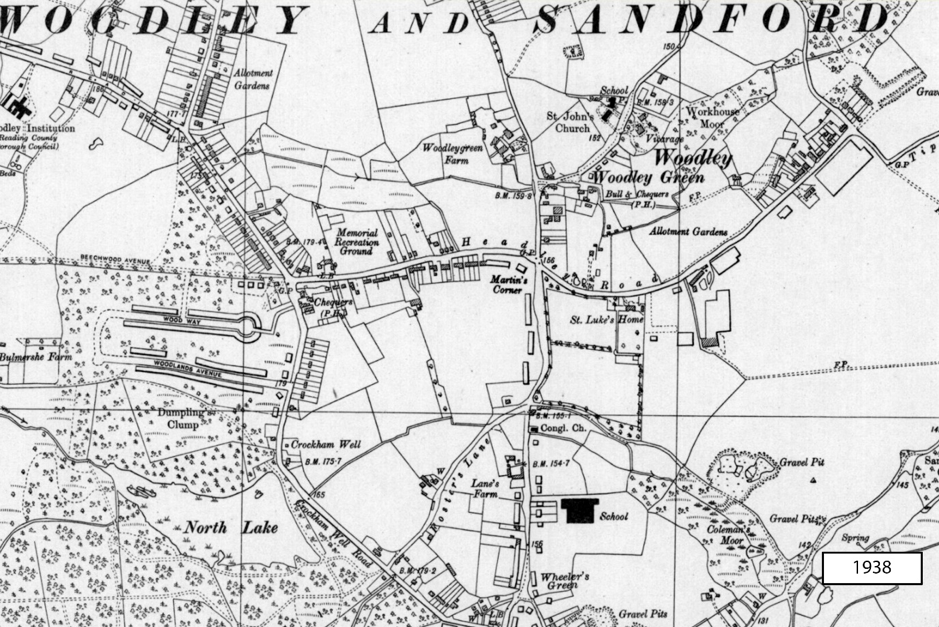
The 1938 Ordnance Survey map above shows the future layout of Beechwood Avenue, Woodwaye and Woodlands Avenue.
By the time war broke out in 1939, Woodley was still a village surrounded by farms. But it was changing. The population doubled. Farmland was sold for housing. It had an influx of workers who came to Phillips and Powis, later Miles Aircraft. St Luke’s Home for Sick Children in Headley Road closed in 1936 because the aircraft factory buildings nearby made the location unsuitable. A second school, a district nurse, a police station, new shops in Headley Road and Loddon Bridge Road, garages and cafes, doctors, hairdressers and music teachers provided services for the growing population.
Sources
Amos, Peter Miles Aircraft: The Early Years, Air Britain (Historians) Ltd 2009
Temple, Julian, Wings Over Woodley, Aston Publications 1987
All sales catalogues courtesy of Ian Couper and from Reading Central Library.
Kelly’s directories 1900-1939 in Reading Central Library
The Reading Mercury and Berkshire Chronicle newspapers in Reading Central Library
